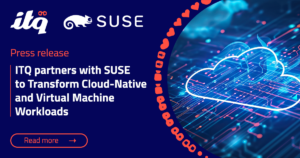It’s starting to become some sort of a tradition: like the last few years Barcelona is the venue of the European leg of VMworld. As became clear when we visited VMworld US last month, there is a lot of attention for a new movement in the world of IT: cloud native applications. During VMworld Barcelona, VMware’s vision with respect to this movement is elaborated on.
Cloud native
Some years ago, the ability to deliver software was a differentiator. Today, it’s a basic requirement for survival. Just one example are sound systems which are bought primarily because they conveniently and wirelessly play music streamed from an online service (e.g. Spotify) everywhere in your home. We kind of trust the sound quality – the core business – will be good enough, and buy the product for the software defined extras.
So when everyone can deliver software, the new differentiator becomes speed to market. It’s about getting an idea into production as fast as possible without throwing resilience and stability out of the window. Applications developed this way are termed ‘cloud native’, and the success of companies leading the way (Netflix, Google) is tantamount.
Applications? Didn’t VMware do infrastructure?
And VMware still does. Where VMware uses the term ‘cloud native applications’ it’s essentially still about infrastructure. An essential ingredient to go fully cloud native is to install a Platform-as-a-Service (PaaS) on top of the virtualized infrastructure. VMware’s announcements like vSphere integrated containers and the Photon platform are meant to facilitate this process.
Dev + Ops, and the end of shadow IT
One of the advantages of having a PaaS platform is the API based collaboration: instead of letting developers submit tickets for getting machines to run their code, the IT department can reserve some set amount of resources, and let developers host applications on them by talking to an API.
This way, the traditional wall between Dev and Ops, responsible for resource allocation times in the order of days or even weeks, is broken down. Developers will no longer feel the need to find refuge in 3rd party PaaS/IaaS platforms like AWS, which has the problem of creating a ‘shadow IT’ over which nobody has control.
First steps: vSphere integrated containers
vSphere integrated containers are a new technology which makes (Docker) containers visible directly in vSphere, the way Virtual Machines (VMs) are right now. This enables applications to be run as containers inside the existing infrastructure, with all the management and monitoring options we are used to for VMs.
A mature solution: Photon platform
Although vSphere integrated containers are a full-fledged solution for running apps as containers on existing infrastructure, running containers is not the final goal. The real goal of the cloud native and DevOps movements is to rapidly go from idea to production, and a real PaaS platform is required to get to this goal.
In principle, it’s possible to create a homebrew platform yourself using various open source and proprietary parts and bolt them together with software. A lot of companies are in fact already experimenting with this. However, for real production use it’s more likely companies will not try and build their own car but instead buy a battle tested, production ready ‘it just works’ platform such as Pivotal Cloud Foundry: an enterprise ready PaaS platform which includes all the essential ingredients like dynamic routing, application health management and zero downtime platform updates.
The Photon platform enables seamless integration between the virtualized infrastructure (vSphere) and PaaS platforms like Pivotal Cloud Foundry.
What’s in it for me?
As said above, the next few years will be crucial: are you able to keep up with the wave of disruptive newcomers who see IT as an ‘enabler’ and who can go from idea to production in days, or do you keep to the old thinking in which IT is mostly a cost?
VMware is tapping into the cloud native movement, and for the first time makes it possible to jump on the bandwagon without having to reinvent the wheel.

